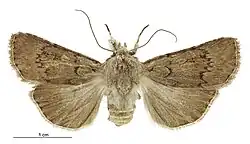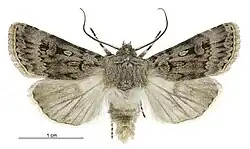Agrotis admirationis
| Agrotis admirationis | |
|---|---|

| |
| Female | |

| |
| Male | |
| Scientific classification | |
| Kingdom: | Animalia |
| Phylum: | Arthropoda |
| Class: | Insecta |
| Order: | Lepidoptera |
| Superfamily: | Noctuoidea |
| Family: | Noctuidae |
| Genus: | Agrotis |
| Species: | A. admirationis
|
| Binomial name | |
| Agrotis admirationis | |
| Synonyms[2] | |
| |
Agrotis admirationis is a moth of the family Noctuidae.[3] It is endemic to New Zealand. It was first described by Achille Guenée in 1868.
Taxonomy
This species was first described by Achille Guenée in 1868 from specimens collected by Richard William Fereday.[4] In 1887 Edward Meyrick redescribed what he thought was this species.[5] George Hudson pointed out in 1898 that Meyrick was describing a new species that Hudson named Agriotis innominata.[6] Hudson discussed and illustrated A. admirationis in his 1928 book The butterflies and moths of New Zealand under the name Euxoa admirationis.[7]
Description
Guenée described this species as follows:
Superior wings smoky-grey, with the ordinary lines much sinuated, blackish and edged with greyish-white atoms; the two median lines very distant, almost parallel; the elbowed line not angulated inferiorily ; the three stigmas pale grey encircled with black; the reniform almost touches the elbowed line, and is surrounded by blackish shades; the orbicular very oblong, pyriform, and its apex almost reaching the reniform; the claviform is very oblong and distinct; the sub-terminal line vague; the hinder margin marked with black dots: inferior wings uniformly grey with whitish fringes preceded by vague black dots; beneath they are whiter with a well-marked cellular spot and median shade. Thorax very robust, grey mixed with black, with a blackish line on the anterior part of the collar. The head is darker, and so are the palpi, the last joint of which is long and truncated. Antennae strong, pectinated.[4]
Distribution
A. admirationis is endemic to New Zealand.[1] This species can be found throughout the North Island and South Island.[7]
Habitat and hosts
This species favoured larval host plants are herbs found in open areas.[8]
References
- ^ a b "Agrotis admirationis Guenée, 1868". www.nzor.org.nz. Landcare Research New Zealand Ltd. Retrieved 12 January 2017.
- ^ Registry-Migration.Gbif.Org (2019). "Agrotis admirationis Guenée, 1868 - Checklist View". www.gbif.org. GBIF Secretariat. doi:10.15468/39omei. Retrieved 12 January 2017.
- ^ Yu, Dicky Sick Ki. "Agrotis admirationis Guenee 1868". Home of Ichneumonoidea. Taxapad. Archived from the original on November 4, 2018. Retrieved January 26, 2017.
- ^ a b Achille Guenée (1868). "New species, &c., of heterocerous Lepidoptera from Canterbury, New Zealand, collected by Mr. R. W. Fereday". Entomologist's Monthly Magazine. 5: 38. ISSN 0013-8908. Wikidata Q104214297.BHL page 43229695
 This article incorporates text from this source, which is in the public domain.
This article incorporates text from this source, which is in the public domain.
- ^ Edward Meyrick (1887). "Monograph of New Zealand Noctuina". Transactions and Proceedings of the New Zealand Institute. 19: 33. ISSN 1176-6158. Wikidata Q104048034.
- ^ Hudson, George Vernon (1898). New Zealand moths and butterflies (Macro-lepidoptera). London: West, Newman & Co. p. 31. doi:10.5962/bhl.title.7912 – via Biodiversity Heritage Library.
- ^ a b Hudson, G. V. (1928), The butterflies and moths of New Zealand, Illustrator: George Hudson, Wellington: Ferguson and Osborn Limited, p. 47, LCCN 88133764, OCLC 25449322, Wikidata Q58593286BHL page 61899629
 This article incorporates text from this source, which is in the public domain.
This article incorporates text from this source, which is in the public domain.
- ^ Patrick, H.J.H.; Bowie, M.H.; Fox, B.W.; Patrick, B.H. (2011). "The moths of Quail Island (Otamahua): a faunal comparison of an island under restoration with other sites on Banks Peninsula" (PDF). New Zealand Natural Sciences Journal. 36: 57–72. Archived from the original (PDF) on 2016-03-03. Retrieved 2017-01-26.